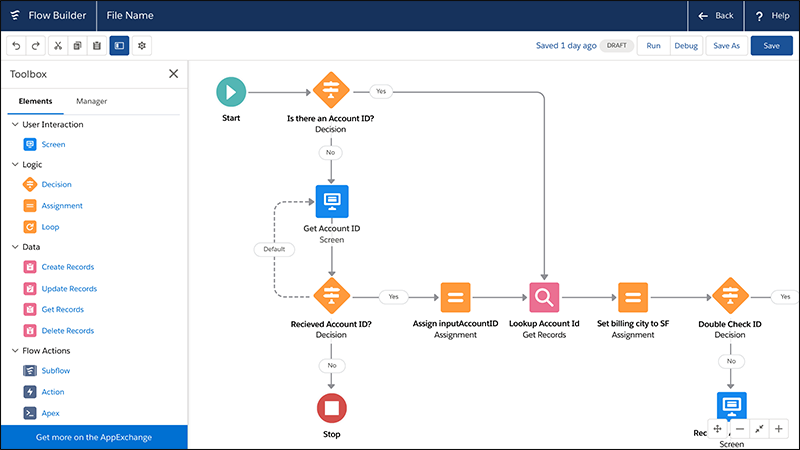Recommended Info For Choosing application development with Low-code platforms
Recommended Info For Choosing application development with Low-code platforms
Blog Article
Benefits Of Low-Code Application Development In The Sense Of Accessibility For Non-Developers
Low-code application development significantly improves accessibility for non-developers. They are often referred to as "citizen developers," because of a variety of key aspects: Intuitive visual interfaces:
Drag-and-drop Builders: Lowcode platforms include drag-anddrop interfaces to enable non-developers to create visually appealing applications, without having to code. This makes development more accessible to those with no technical background.
WYSIWYG Editors: "What You See Is What You get" editors let users design interfaces and workflows in a manner that closely resembles the actual product, which makes it much easier to comprehend and use.
Simplified workflow and logic
Visual Workflow modeling: Users design business processes and application logic using visual flowcharts. These models are easier to use than traditional code methods.
Low-code platforms usually have pre-built logic elements (e.g. statements that are conditional loops, conditional statements) which can be easily set up, reducing the need for complex coding.
Reusable components and templates:
Libraries of pre-built templates: A lot of low-code platforms offer libraries for the most common types of applications, providing non-developers a solid base to build on and later alter.
Reusable Modules and Widgets: Utilizing reusable modules and widgets, users can streamline the creation process and reduce the requirement for technical knowledge.
Guided Development and Tutorials
Step-by -Step Instructions Platforms typically offer tutorials that are on screen, guided development routes as well as other tools to assist people who are not developers to create applications.
Interactive Tutorials Interactive tutorials that let you engage with the platform can aid in learning and increase confidence.
Integration of existing tools:
Easy Integration - Low-code platforms are easily integrated into existing business tools and systems (e.g. ERP, CRM) that give even non-developers the ability to develop apps that work to their workflows.
APIs and Connectors : APIs built-in and connectors let users and non-developers to connect applications to external services without the need for complicated programming.
Collaboration Features:
Team Collaboration: real-time collaboration, shared workspaces and shared workspaces allow business analysts, non-developers and other stakeholder groups to effectively work with professional developers.
Access Control based on Role: Users who are not developers can be assigned specific roles and access levels. This enables them to contribute to the development without compromising security or functionality.
Automated Testing & Debugging
Low-code platforms have tools for testing and debugging which are built into. They automatize the procedure, making it much easier for nondevelopers to make sure their apps function.
Error highlighting: The system highlights issues and suggests fixes to guide non-developers.
The capability of low-code apps to make development accessible to non-developers is their biggest benefit. By providing intuitive, visual tools and guided experiences, low-code platforms allow business users to participate actively in developing and maintaining applications, which bridges the gap between business needs and the technical implementation. Read the recommended he said about Low-code Platform for application development for more advice including rad development, cross platform app dev, azure sql, sso azure, build with docker, driver jdbc, cross platform mobile app development, cross platform app development, application modernisation, rapid applications and more.
Benefits Of Developing Applications Using Low-Code With Respect To Governance And Security
Low-code applications offer several benefits in terms of cybersecurity and governance that are essential to ensure that all apps are managed, well-managed, and compliant throughout their lifespan. These are the benefits of developing low-code applications:
Unified management console Low-code platforms usually provide a central administration console from which administrators manage all applications and ensure consistent governance within the organization.
Role-Based Access Control RBAC: These platforms come with robust controls based on role that allow administrators to define access policies. Only authorized users are allowed to modify and access specific areas of an application.
The Compliance Process and Regulatory Adherence:
A majority of low-code platforms include security features for compliance. They are built to meet industry standards and regulations such as GDPR or HIPAA. They provide frameworks and tools that help to ensure applications meet these requirements.
Audit Trails and Logging: Audit trails and logs that are comprehensive are typically integrated, allowing companies to track changes, monitor access and make sure that they are in compliance with internal and external rules and regulations.
Increase Security Measures
Data Encryption: Low-code platforms typically provide built-in encryption for data in transit and in transit, ensuring that data with sensitive information is secure.
Security Certificates: Many low-code companies have a security certificates (e.g. ISO 27001 and SOC 2) which demonstrate their adherence to strict security guidelines. They provide an additional level of assurance to customers.
Automatic security updates for security:
Regular updates and patching Low-code platforms can handle the majority of security patches and updates automatically. They ensure that applications are safe from the most recent attacks without the need for developers to intervene manually.
Security Monitoring Tools: These instruments give alerts in real-time and insight into potential security problems.
Data Governance:
Data Access policies: These platforms help organizations define and enforce their data access policy to ensure that only authorized users have access to data and that it is correctly used.
Data Masking Anonymization The built-in tools for data masking and anonymization features help protect sensitive information, particularly in testing and development environments.
Continuous application lifecycle management
Pipelines for Development and Deployment Low-code platforms usually offer integrated pipelines for development and deployment which include security checks, ensuring that security is maintained throughout the application lifecycle.
Version Control: Integrated version control is a way to manage changes and ensures that any modifications to the application will be tracked and reverted if necessary, maintaining the integrity of the application.
User Authentication Authorization
Single Sign-On (SSO). Support for advanced authentication and single sign-on makes it easier and enhances security.
Multi-Factor Authentication Numerous platforms are equipped with built-in functionality for multi-factor verification that adds an extra layer for security.
Policy Enforcement Monitoring and Compliance:
Policy Templates: Low-code platforms usually have pre-defined templates for governance and security which allow companies to swiftly implement policies.
Compliance Monitoring Tools: These tools provide continuous monitoring and reporting on compliance status, making it easier to recognize and resolve possible issues in advance.
Integrate with the existing security infrastructures:
Seamless Intergration: Low code platforms are designed to allow seamless integration with security tools and equipment, including Identity Management Systems, SIEM Solutions (Security Information and Event Management), and Firewalls.
API Security: Built in API security features safeguard information, guarantee integrity of the application and secure integrations.
Training and best practices
Guided best practices: Many platforms include guidelines and recommended procedures for the creation of secure applications. They help non-developers comply with security requirements.
Some lowcode providers provide tools and security education for users to learn how they can build and maintain secure applications.
Overall, the governance and security benefits assure that applications are built and managed securely and in accordance with regulations, and under control. These platforms provide the tools and frameworks necessary to protect sensitive data as well as enforce policies and ensure compliance with regulatory requirements, all the while facilitating the management and oversight of the development process. Check out the most popular read this about Legacy application modernization with Low-code for blog tips including rad application development, cross platform mobile development, driver jdbc, develop web application, developing mobile apps, rad development, rapid applications, low code development platforms, cross platform mobile dev, develop cross platform mobile app and more.
Advantages Of Low-Code Application Development In Terms Of Collaboration And Workflow
Low-code development has many advantages for collaboration and workflow. This is why it is a perfect solution for businesses seeking to boost productivity and simplify the process of development. Here are the key advantages: Improved Cross-Functional Collaboration:
Unified Development Environment: Low-code platforms provide a single, unifying environment in which all team members such as developers, business analysts, designers, and other stakeholders can work efficiently. This eliminates silos.
Visual Development Tool: The drag-anddrop nature of platforms using low-code makes it easier for team members who are not technologically inclined to participate in the process of development. They will assure that business needs will be accurately captured and implemented.
Advanced Communication
Real-Time Co-operation: A lot of platforms with low-code support real-time co-operation capabilities like commenting, editing in parallel, and receiving immediate feedback. They enable continuous communication by reducing the time needed for back-and-forth discussions.
Workspaces shared by teams. Teams are able to collaborate in shared workspaces. Here, they can see, edit, and discuss various project components.
Streamlined Workflow Management:
Integrated Project Management Tools: Many low-code platforms come with integrated tools for project management which can assist teams to track and organize their projects for development. This includes task assignment, progress tracking, and deadline management.
Workflow Automation: Automating routine tasks and workflows decreases errors and manual labor, allowing teams to focus on more strategic activities and improving overall efficiency.
More efficient Iteration cycles
Rapid Prototyping : Low-code systems enable rapid prototyping. They also allow rapid and iterative development. This allows teams to develop apps, test them and refine them within shorter time frames. This ensures feedback can be quickly integrated and improvements are made.
Support for Agile Methodologies Using agile practices gives teams to be agile and work in sprints, and to continuously provide small amounts of functionalities, making it easier to adjust to changing requirements.
Accessibility for non-developers
Citizen development: Low-code platforms allow business users to create and modify applications without extensive programming knowledge. This alleviates the burden of IT and development teams and facilitates faster response to business requirements.
Training and Onboarding. The simple interfaces of training tools allow new members to get acquainted with the system and this helps improve collaboration.
Centralized documentation and knowledge sharing:
Low-code platforms usually have tools for creating, managing and storing documentation within their platform. This lets all the project information to be centrally stored and easily accessed.
Knowledge Repositories : Teams can create knowledge repositories. These contain templates, best practices, and reused components. This helps in sharing knowledge and helps reduce duplication of effort.
Consistency and uniformity:
Standardized Components. Utilizing standard components that are pre-built allows for consistency across all applications. This allows team members to learn and collaborate with various aspects of their projects.
Governance and Compliance: Integrated within governance frameworks, the frameworks for governance ensure that all development adheres to the standards of the organization and requirements of the regulatory environment, reducing risk of non-compliance and ensuring that applications meet high quality standards.
Feedback Loops and Improvement Loops
Integrated Feedback mechanisms: Platforms with low-code usually have an integrated feedback mechanisms, which allow users to provide feedback to applications. Feedback can then become part of the development.
Continuous Improvement: The ability to quickly iterate and implement changes based on feedback assures the continuous improvement of apps that are in line with the needs of users and business goals.
Visualization, Reporting and Analysis
Real-time analytics: Built-in analytical and reporting features give real-time insight into the progress of projects, their performance and user interaction. They enable an informed, data-driven decision-making.
Visual Workflow Mapping: Visual tools used to create workflow maps can be used by teams to improve workflows. This can help them pinpoint the bottlenecks, as well as areas of improvement.
When it comes to collaboration, low-code applications are an excellent way to simplify workflows, bring teams from different backgrounds together and automate tasks. This creates a flexible, collaborative and productive developing environment that produces better-quality applications.